
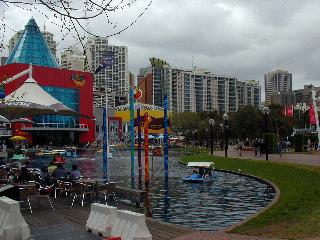 |
We started the morning by walking down to Darling Harbour to see what was happening down there. Besides games and rides that seemed a lot like the Rose Festival Fun Center, we heard a jazz band that played for a while. |
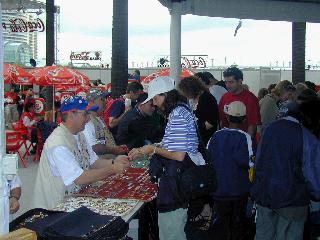 |
But the highlight of the morning was our first foray into Olympic pin trading at the Coca-Cola pin trading pavilion. We had a modest collection of pins given to us by Cartan Tours, and it turned out that they were actually reasonable desirable. Janet made our first trade of the day; here she is looking extraordinarily proud of her new acquisitions. |  |
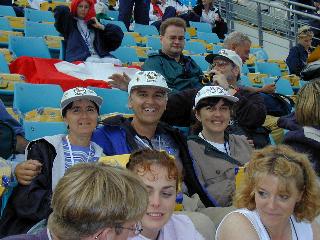 |
We had what seemed to be excellent seats, far enough up the arena to
get a good view of the proceedings, but not up in the nosebleed section.
In fact, we were right behind the stage area that held the orchestra and
other notables who appeared throughout the evening. In each of our
seats, we found a "goodie box" with things we'd need to help pitch in with
the evening's performance.
While we waited, we got to meet Jin DeSilva, one of the world's foremost collectors of Olympic memorabilia. Turns out he was also Sri Lanka's entrant in the 400m race in the 1948 Games in London, and currently maintains the Honolulu home of a famous pineapple heiress. Way cool. And a little while before the ceremony started, he pressed four Olympic pins into Janet's palm from various past Games. |
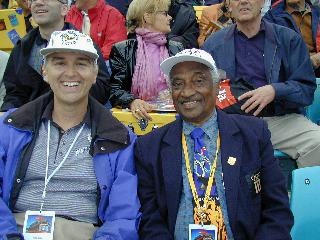 |
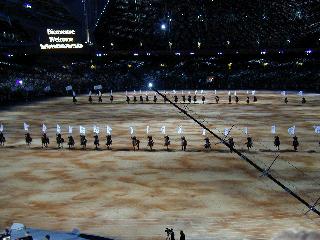 |
The extravaganza part of the Opening Ceremonies was awesome, as you may have seen on TV, although NBC undoubtedly didn't do it justice. All 110,000 attendees helped count down the final ten seconds until the Games kicked off. Then a lone horseman galloped into the arena, followed closely by over a hundred others evoking The Man from Snowy River and welcoming the world to Australia. Fanfares accompanied Australia's head of state and other dignitaries, and we got a stirring rendition of the Australian National Anthem. | 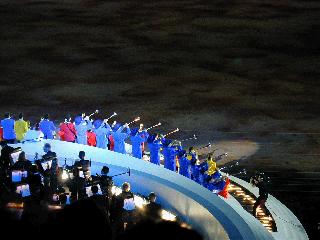 |
Then we went through a series of scenes recounting the history of Australia
since time began. (Italicized quotes throughout the following descriptions
come from the Opening Ceremonies Program.)
| First was the time of Deep Sea Dreaming, harkening back to the aboriginal Dream Time during which the gods arose and created the earth and all that's in it: "A young girl spreads out her beach towel and dreams. Giant translucent jellyfish drift through her marine imagining and she swims in a seeping ocean of fish, stingrays and anemones." Here you can see some of the giant jellyfish and other giant marine life swimming above the arena while dozens of kids in fish costumes scurry about beneath. The "young girl" was a 13-year-old actress who soared to the very top of the arena, "swimming" through the ocean waaaaay above the arena floor. "White ochre spirits join the whirlpool and carry her to the stage where a silhoutted figure waits. he is Djakapurra, the great tribal dancer, who will guide her dream journey." | 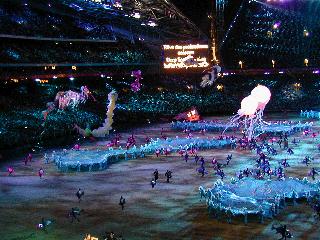 |
| Next: The Awakening. "Djakapurra Munyarryun, the songman, calls the new generation of spirits. The white ochre spirits are drawn to the heartbeat of the land by Central Desert women. Torres Strait Islanders arrive; the Eora nation group welcomes and plays host. As the clans unite, they birth a giant Wandjina -- ancestral creation spirit and lawmaker. With a roar of thunder, the Wandjina flings a lightning bolt to ignite the bushfire that will regenerate the land." | 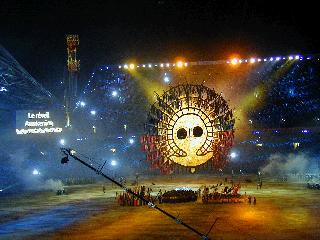 |
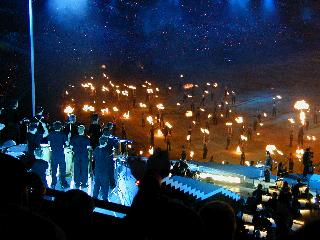 |
Flame everywhere! Fire batons, fire twirlers, fire eaters spread across the floor of Olympic Stadium. And the audience created its own fire renditions by switching on our official Cheerbands (wristbands with blinking red lights) and waving them wildly (you can see them in the crowd in the photo). "The spirits from Awakening are driven away by the searing plumes of fire. Many Aboriginal legends and creation stories relate to fire and how it was obtained. Flames cleared the undergrowth, and encouraged plants which needed fire in their life cycle." |
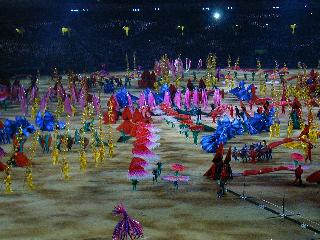 |
Then the rains came. The fires were extinguished and plants bloomed. In the pageant, those plants were made up of hundreds of costumed "plant parts" that swirled across the arena, forming patterns, breaking apart, reforming others. In many ways, it resembled an even more compelling version of some segments of Walt Disney's Fantasia. And as this section climaxed, the arena lights went down and the plants glowed with lights from within. "The draatic Grass Tree bursts forth exuberantly from the charred earth. Gum trees grow eagerly, and the crimson Sturt Pea blooms in the desert. Djakapurra walks through the garden and stops at one flower, where the young girl is dreaming." | 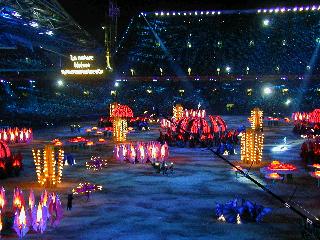 |
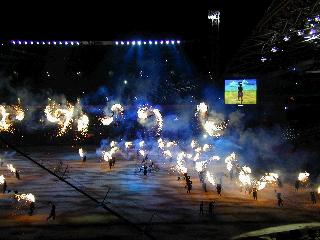 |
"For 60,000 years, Aboriginal people managed to survive in the harsh Australian landscape through knowledge of the land. The settlers who followed the First Fleet relied upon a very different approach to their environment. Tin Symphony is a celebration of the energy, humour and ingenuity that drove the settlement of the Australian Bush." Captain Cook arrives; outlaw Ned Kelly is recalled (left), and a bizarre machine recalls the improvised machinery of cogs, drive belts, and pulleys that were a standard feature of Bush settlements. | 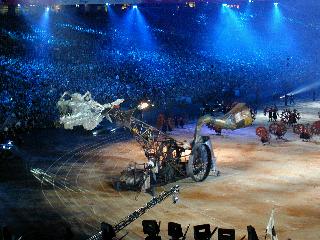 |
| "The history of modern Australia is the history of migration. New arrivals form the Olympic symbol that unites the five continents of the world. Two thousand children gather to form the distinctive pattern of the Southern Cross in the night sky." And Nikki Webster (the dreaming child) sang "Under Southern Skies" to celebrate unity. | 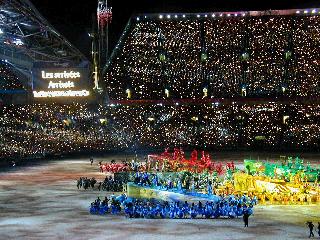 |
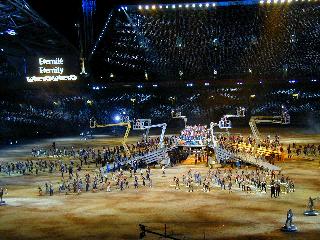 |
Eternity (the last segment) was a tribute to all the workers who helped make Australia great. After building a giant platform, the performers did some industrial-strength tap dancing on and around it, led by the team from the hit musical Tap Dogs. "The bridge is the bridge of life, of connection and reconciliation. All the performers from the Opening Ceremony gather around the structure, and a form a mandala. Djakapurra and the young girl meet again under a shower of brilliant pyrotechnics." |
| Then it was time for the Parade of Nations. A HUGE marching band (even larger than the One More Time Around Again Marching Band) took the field and began to play. And eventually we discovered that this was only part of the band; soon the woodwinds and additional players marched out of the stands and onto the field to join them. In the end, over 2,000 players from all over the world were led by 8 conductors in a performance that "warmed them up" to play throughout the Parade of Nations. | 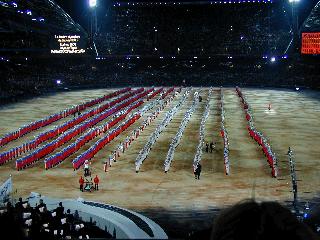 |
The parade of the athletes was a true panoply of color. The Japanese looked like Snowlets from the Nagano Games in their multi-colored cloaks. The US contingent was huge and well-cheered; the Aussies got WAVES of sound coming down from everywhere. Eventually the infield was filled with a riot of color and 10,000 athletes. Very cool.
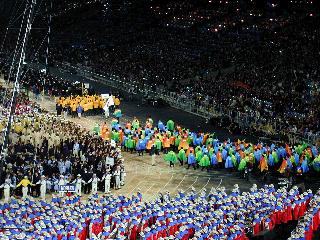
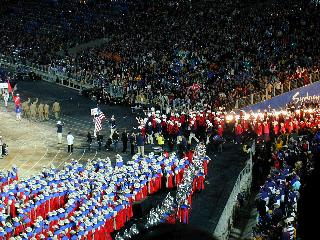
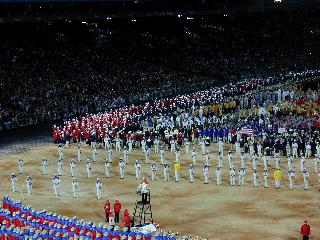
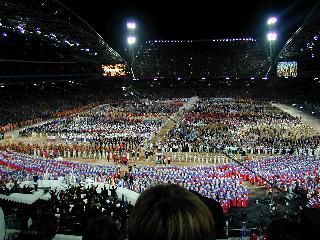
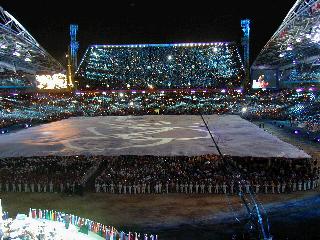 |
A huge sheet was drawn down over the crowd at the far end of the stadium, then dropped to the infield floor where it was pulled across the entire collection of athletes. The Olympic Rings were projected on this makeshift screen. Then eight of Australia's great former Olympians presented the Olympic Flag that would fly over the Games. |  |
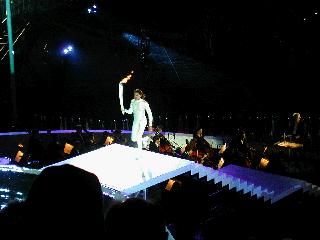 |
And then the lighting of the Flame. What appeared to be a solid platform just below us opened up and became a pool of water, with a waterfall rushing down the height of the stadium into it. And that's when we figured out that our seats were really fabulous, being perhaps 50 feet from the actual lighting of the flame! Cathy Freeman, Australia's Olympic 400m champion and current world record holder, ran up the steps, walked into the water, and ignited the Flame. | 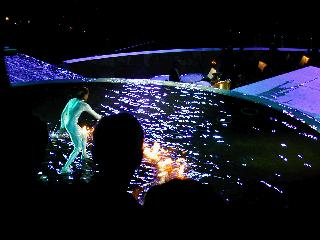 |
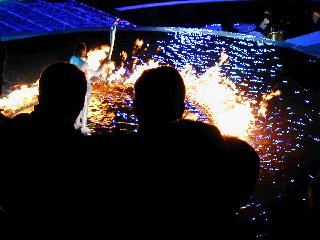 |
The flames rose in a circle around her. Then, as she stood seemingly on the surface of the lake, the flames of the cauldron rose up around her and then hovered on the stadium wall. We could feel the heat from the roaring flames from where we stood! | 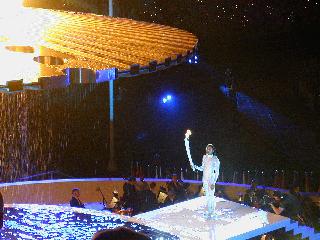 |
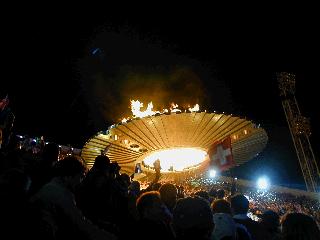 |
Finally, the cauldron began levitating up the waterfall to the top of the stadium. | |
| As it arrived, fireworks blossomed over the stadium in celebration. | 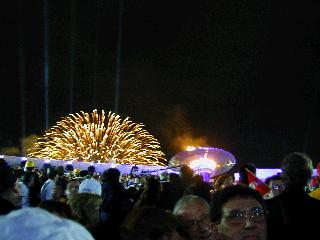 |
|
| And finally the cauldron extended itself further into the night sky to form the Olympic Flame that will preside over the games for the next 17 days. Wow, Wow, Wow! | 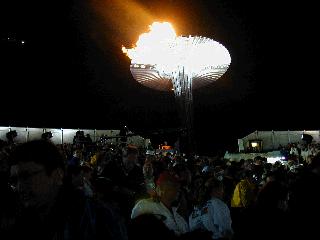 |